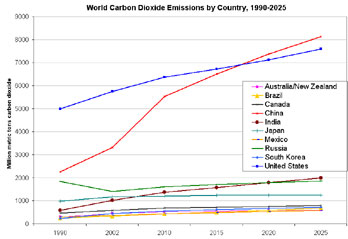China and India show rapid increase in global warming emissions
China and India show rapid increase in global warming emissions
World Bank
May 10, 2006
Greenhouse gases on the rise, China and India show rapid increase; Rich countries consume more than half the energy produced in the globe; Poor countries still depending on traditional fuels
Carbon dioxide (CO2) emissions continue to rise with a mix of old and new polluters, according to the Little Green Data Book 2006, launched today on the occasion of the Fourteenth Session of the United Nations Commission on Sustainable Development (CSD-14). An annual publication of the World Bank, according to this year’s edition, CO2 emissions worldwide have now topped 24 billion metric tons (the most recent comprehensive data are for 2002), an increase of 15 percent compared to the 1992 levels.
The rapidly expanding economies of China and India are showing a swift increase in CO2 emissions. China, which is already the second largest polluter, has increased its emissions by 33 percent between 1992 and 2002, while India’s emissions have grown 57 percent in the same period. This trend will likely continue as economic activity grows.
Such an increase in emissions has taken place despite improvements in energy efficiency by China in the last decade. In 1992, a dollar of GDP was associated with the production of 4.8Kg of CO2. In 2002, every dollar of GDP was associated with 2.5Kg of CO2.
Still, CO2 emissions stem mainly from rich countries, with the United States contributing 24 percent of total emissions and the countries of the European Monetary Union contributing 10 percent. But the share of developing country contributions to CO2 emissions is rapidly increasing. From 2000 to 2002, global CO2 emissions increased by 2.5 percent annually, and about two-thirds of this increase came from low and middle income countries.
According to Steen Jorgensen, Acting Vice-President for Sustainable Development at the World Bank, “This reality shows us that we need to find creative ways to engage all major economies of the world to solve a global problem such as climate change. The recently launched Investment Framework for Clean Energy and Development is an attempt by the World Bank to contribute in this direction.”
  Greenhouse gases hit record in 2005 Levels of gases believed to be fueling global warming continued to climb in 2005 according to analysis released by the U.S. National Oceanic and Atmospheric Administration (NOAA). The agency said its index of greenhouse gases — the Annual Greenhouse Gas Index or AGGI — showed an increase in carbon dioxide (CO2) and nitrous oxide but a leveling off of methane, and a decline in two chlorofluorocarbons (CFCs), gases that contribute to the hole in the ozone layer above Antarctica. NOAA reports that overall, the AGGI “shows a continuing, steady rise in the amount of heat-trapping gases in the atmosphere.” Greenhouse gas emissions will rise by 52% by 2030 warns EIA The International Energy Agency (EIA) today released a report projecting that global greenhouse gas emissions will rise by 52% by 2030, unless the world takes action to reduce energy consumption. Further, the IEA says that oil prices will rise “substantially” unless there is extra investment — $20.3 trillion in fresh facilities by 2030 — in oil facilities. China and India Key to Ecological Future of the World, Says Report Earth lacks the energy, arable land and water to enable the fast-growing economies of China and India to attain Western levels of resource consumption according to a new report released by the Worldwatch Institute. In it’s “State of the World 2006” the environmental think tank says China and India, are becoming not only economic powers, but “planetary powers that are shaping the global biosphere” and affecting world economic policies. “The world’s ecological capacity is simply insufficient to satisfy the ambitions of China, India, Japan, Europe and the United States as well as the aspirations of the rest of the world in a sustainable way,” says the report. |
|
Jorgensen was referring to a new approach — the Clean Energy & Development: Towards an Investment Framework — recently endorsed by the Governors of the World Bank designed to boost energy investments while reducing greenhouse gas (GHG) emissions.
“All countries are vulnerable to climate change,” says Warren Evans, Environment Director, World Bank, “but the poorest countries are the most exposed, and have the least means to adapt to it. Climate change may hamper efforts to reduce poverty in agriculture-dependent countries in Africa and low-lying coastal areas. Climate proofing development initiatives is an urgent need in order to avoid human disasters.”
CO2 emissions stem mainly from the combustion of fossil fuels. The energy sector accounts for about 80 percent of greenhouse gas emissions and the agricultural sector for most of the remaining 20 percent (source: Clean Energy and Development: Towards an Investment Framework, the World Bank, April 23, 2006).
“Coal is by far the main source of energy for electricity generation,” says Jamal Saghir, Director Energy & Water, World Bank. “The relevance of coal has increased over time, particularly in low-income countries where the share of electricity generated by coal has shifted from 41 percent in 1990 to 46 percent in 2003. In China, the use of coal has increased from 71 percent in 1990 to 79 percent in 2003. In India, the increment has been from 65 percent to 68 percent.”
Energy use per capita is highest in rich countries, which consume on average 11 times more energy per person than low income countries. High income countries in total use 51 percent of the world’s energy production, followed by East Asia and Pacific, 18 percent, and Europe and Central Asia, 13 percent.
While rich countries have developed modern sources of energy, wood fuels are still the primary source of energy for approximately 2 billion people in poor countries. Solid biomass is associated with respiratory problems caused by indoor smoke. Most of the victims are infants, children, and women from poor rural families. Acute respiratory infections in children and chronic pulmonary disease in women are a common feature.
Indoor smoke accounts for 3.6 percent of the burden of disease in developing countries with high mortality, following the lack of water supply and sanitation which accounts for 5.5 percent of death and illness.
The data shows very little progress in the past 10 years. In low income countries, the use of biomass products and waste as a percent of total energy use has gone from 55 percent in 1992 to 49 percent in 2003.
At the same time, livelihoods of the rural poor depend heavily on the ecosystem capacity to provide a sustained source of energy, and in some regions fuel wood crises may take place in the next decade with subsequent effects on ecosystems.
Countries rich in fossil energy resources on an unsustainable trajectory
Are countries saving enough for future growth? The Little Green Data Book shows that, by and large, countries with large endowments of fossil energy resources choose to consume rather than to invest the returns generated by energy resources. Sub-soil wealth is not being transformed into assets necessary to sustain growth.
Countries such as Angola, Nigeria, and Venezuela, that enjoy high energy returns, have negative saving rates. In these countries, total wealth — the sum of man-made, natural, and human capital — is declining, posing serious risk on the sustainability of future growth rates.
A negative savings rate implies that welfare will decline at some point in the future as a result of decisions made today. Sustainability in the Middle East and Sub-Saharan Africa appears very low once traditional savings measures are adjusted to take into account the loss of natural capital. By contrast, East Asian economies, such as China and the Philippines, enjoy very high savings rates. For these countries, asset accumulation is a precondition for future growth.
Commenting on how the LGDB is developed, Eric Swanson, Program Manager for global monitoring in the World Bank’s Development Data Group, says that, “The Little Green Data Book is the World Bank’s comprehensive guide to environmental statistics. With data for 48 indicators in 222 countries, territories, and regions, it provides a statistical portrait of the state of the world and the impact of human activity.”
The Little Green Data Book draws on the World Bank’s recently released World Development Indicators database and makes key development indicators widely available to a global audience.
For a copy of the Little Green Data Book, please go to:
www.worldbank.org/environmentaleconomics
For more information on the Clean Energy & Development: Towards an Investment Framework,
please see the website:
www.worldbank.org/sustainabledevelopment
This article is a modified news release from the World Bank.